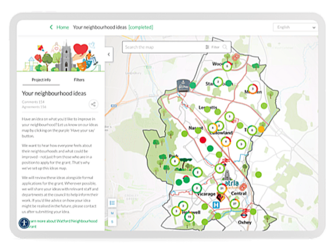Seen and heard: Working with citizens to set their own wellbeing metrics

What are your priorities in life? Do you treasure time at home with family? Is safety and security paramount? Is positive mental health number one? Do public sector investment decisions accurately reflect those priorities, concerns, hopes and dreams?
An experiment in Skultuna, part of the city of Västerås in Sweden, sought to examine people’s priorities through a citizen engagement project. It was carried out in partnership between community engagement non-profit Dark Matter Labs and Samhällskontraktet, a partnership between Mälardalen University, Västerås and the municipality of Eskilstuna, which acted as the ‘community anchor’. The premise for the experiment was to build on the ‘beyond GDP’ movement, which seeks to examine metrics for people’s wellbeing, alongside more traditional economic measures, to determine the strength of a local or national economy and society.
Numerous nations have attempted to build on this concept (see boxout, below), but all of these projects took a ‘top down’ approach. In Sweden, the research team wanted to use civil engagement to allow local people to set their own wellbeing indicators and, therefore, use a much more ‘bottom up’ process.
The researchers began by identifying a local authority team in Skultuna that was looking to run scenario-planning workshops based around a theme of what Skultuna could look like in 2035, together with potential strategies to achieve goals and mitigate threats. The researchers worked with the local authority to run workshops with citizens in Skultuna, examining what wellbeing indicators local people prioritised.
“We really wanted the indicators to be social connectors,” explains Emily Harris, finance and economic innovation lead at Dark Matter Labs. “We thought we should go out there and do it in person. There is no point in only having theories about why things are not progressing.”
Engagement is an issue in many civic engagement projects, and, as a potential problem, it was firmly in the minds of the research team. “One of the big challenges we had was communicating to people about why it should matter,” Harris adds.
“People like to talk about what they want in their communities up to a certain point. Then there’s always the questions of ‘where is it going?’, ‘what is the point?’ and ‘is it actually going to have any impact?’ Our challenge was working out how to express the idea of community engagement in a way people could really connect to. People are scared, people are worried; there’s lots of polarisation. But a lot of the time, people can’t connect what is happening to them on a day-to-day basis to policy issues. They think it is completely irrelevant.”
The team mitigated this issue by connecting issues such as housing affordability with government policy and banking policy, which helped make the ideas seem more relatable, according to Harris.
Several key themes emerged in Sweden. Safety, a good work-life balance, life satisfaction and health were the most popular, and, according to residents, feeling safe and having trust were seen as important for a thriving Skultuna. Personal autonomy, meaning and purpose were more important factors in wellbeing than happiness or self-expression. The local population’s biggest areas of concern for the decade ahead were war, the economy and climate change.
This led to the agreement of a number of indicators – metrics that would help people determine how wellbeing was performing in the local community. The five indicators chosen by the people of Skultuna were:
- the proportion of the population that had taken part in regular activities with non-family members once a week
- the number of people on a Sunday evening feeling positive for the week ahead
- the percentage of people who would recommend moving to Skultuna
- the proportion of people who do not own a car; and
- the number of people who have a dream or plan more than one year into the future.
Harris says the results show that citizen engagement, when done properly, can have a positive impact.
“There’s definitely appetite. Citizen engagement has some negative connotations and it seems like an add-on or a nice-to-have. But when people can run it themselves, and think about what is really annoying or what they really want, and then see it taken forward – helped by an intermediary – it is good.”
The project has since been repeated and expanded upon in Scotland and Canada. In Scotland, Dark Matter Labs worked with Carnegie UK, Northumbria University and Foundation Scotland to create a guide to building an automated framework for people to run their own groups and then feed the analysis into a central database.
There have been previous attempts to build on the
’beyond GDP’ movement:
● The Scottish government’s National Performance Framework, set up in 2007, seeks to improve people’s wellbeing
● Bhutan’s Gross National Happiness Index, created in 2008, measures factors including health, living standards, community vitality, and environmental and cultural resilience
● New Zealand’s wellbeing budget in 2019 measured wellbeing and safety, as well as economic indicators.
ext goes hereext goes here
In Canada, the team will work over the next couple of years with the David Suzuki Foundation, carrying out a similar project with five communities simultaneously, with participation particularly sought from indigenous communities. Communities will be asked to self-select into the project, rather than use the approach taken previously to work with a chosen community.
Most importantly for Harris is the need for wellbeing to feed into government investment decisions, and to give people real say and power in the decisions made locally and at a national and regional level.
“The indicators were never supposed to be the end goal,” she says. “The aim was not to create a lot more data points. Although the indicators are important, and we want people to have ownership of them, the process of them getting to those indicators, understanding what is beneath them, and caring and feeling connected is a huge part of it. What I am really interested in doing is then linking them to public investment decisions.
“We need a new economy, but, so far, I don’t think the political logic of that has been built or thought about properly.
“There are all sorts of movements, and they have great aspirations, but if it is going to happen it has to come from the people. That’s the goal.”
This article was first published in the January issue of Impact.

We hope you enjoyed this article.
Research Live is published by MRS.
The Market Research Society (MRS) exists to promote and protect the research sector, showcasing how research delivers impact for businesses and government.
Members of MRS enjoy many benefits including tailoured policy guidance, discounts on training and conferences, and access to member-only content.
For example, there's an archive of winning case studies from over a decade of MRS Awards.
Find out more about the benefits of joining MRS here.














0 Comments